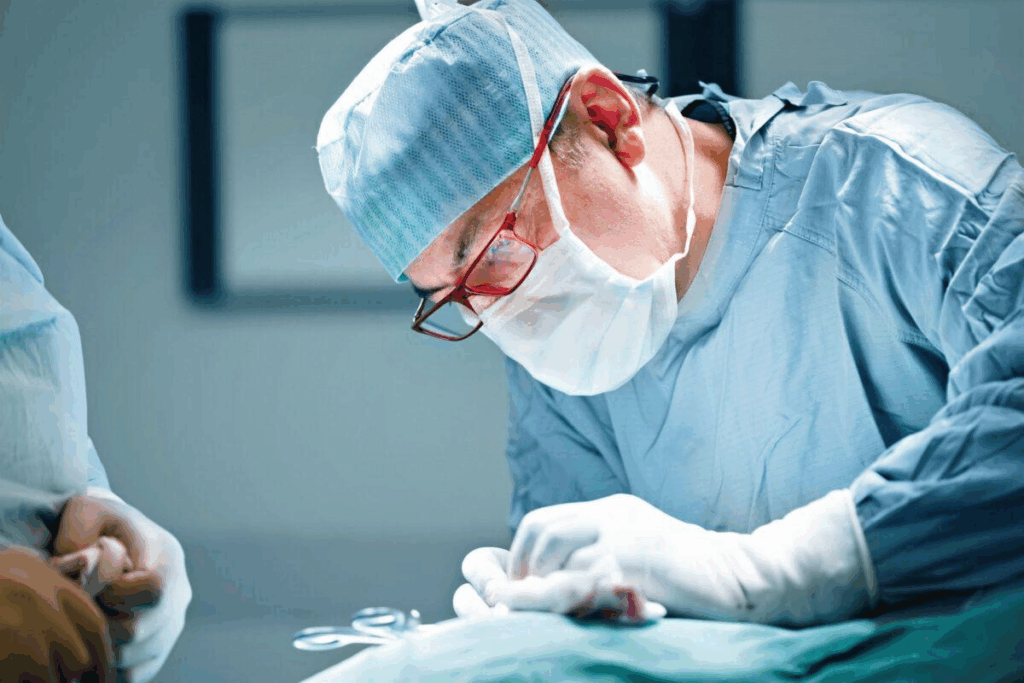Last Updated on November 27, 2025 by Ugurkan Demir

Finding the right surgeon for a deviated septum can be tough. A deviated septum affects many people, causing health problems if not treated.
Septoplasty is a common surgery for deviated septums. It’s important to choose a skilled, board-certified surgeon. They can help you feel better and improve your life.
At top healthcare places, patients get full care. This care follows international standards and focuses on the patient. We’ll help you find the best deviated septum surgeon near you. This way, you’ll get the best care possible.
How to find the best deviated septum surgery (septoplasty) surgeon near you, focusing on expertise and patient reviews.

Many people don’t know how much a deviated septum can affect their life. It happens when the thin wall between the nasal passages shifts. This makes one passage smaller, leading to breathing and health problems.
A deviated septum is when the nasal septum, made of cartilage and bone, moves out of place. This makes one nostril smaller than the other. It can cause breathing trouble and other issues.
“A deviated septum is a common condition that can cause significant health issues if left untreated.” It’s important to know about it to get the right medical help.
Research shows that a deviated septum affects a big part of the population, from 19% to 65%. This range comes from different studies and how they define the condition. But, it’s clear many people deal with this issue.
Genetics, injury, or developmental problems can cause a deviated septum. Knowing how common it is helps us see the need for good treatments.
Symptoms of a deviated septum can really hurt your daily life. You might have trouble breathing, get sinus infections often, or have nosebleeds. These problems can mess with your sleep, daily tasks, and overall happiness.
For example, always having a stuffy nose can make you breathe through your mouth. This can dry out your mouth and harm your teeth. Sinus infections can also hurt a lot, making it hard to focus and do everyday things.
Knowing how common and serious a deviated septum is helps people see why they should get help. Good treatment can make a big difference. It can help you breathe better and live more comfortably.

Some cases of deviated septum need surgery. It’s important to know when non-surgical methods won’t work. This helps in making the right choice.
Non-surgical treatments like nasal decongestants and nasal strips help manage symptoms. But, they don’t fix the problem.
Limitations of Conservative Treatments:
When non-surgical treatments don’t work, surgery is considered. This is called septoplasty. It’s for those who need better quality of life.
Indications for Septoplasty:
Condition | Description |
Significant Nasal Obstruction | Interferes with daily activities or sleep |
Recurrent Sinus Infections | Despite conservative treatment |
Nasal Discharge and Facial Pain | Associated with the deviated septum |
Septoplasty can greatly improve life for those with deviated septum. It enhances nasal function and overall well-being.
Potential Benefits:
The table below shows the big benefits of septoplasty. Many patients see a big change in their symptoms.
Symptom | Pre-Surgery | Post-Surgery |
Nasal Congestion | Severe | Mild |
Sinus Infections | Frequent | Rare |
Quality of Life | Impacted | Improved |
Surgery for a deviated septum includes many options. From old methods to new ones, knowing them helps patients choose wisely.
Traditional septoplasty is the most used surgery for a deviated septum. It makes an incision on one side of the septum. Then, it removes the bone or cartilage that blocks the airway and moves the septum to open up the nose better.
Key aspects of traditional septoplasty include:
Endoscopic septoplasty is a newer version of the traditional method. It uses an endoscope for better views. This makes fixing the deviated septum more precise and might make recovery faster.
The benefits of endoscopic septoplasty include:
At times, a deviated septum comes with other nasal or sinus problems. In these cases, a more detailed surgery is needed. These combined surgeries tackle several issues at once. This can lead to better results and fewer future surgeries.
Examples of combined procedures include:
Choosing surgery for a deviated septum needs a good doctor. They will look at your nose, talk about your symptoms, and suggest the best surgery. This will help you breathe better and live a fuller life.
Every year, about 260,000 septoplasty surgeries are done in the U.S. It’s important to know how safe and effective this surgery is. We’ll look at the numbers that show how well it works and any possible risks.
Septoplasty is very successful, with most patients seeing big improvements. The large number of surgeries done each year shows it works well for deviated septums.
Key success factors include:
Septoplasty is mostly safe, but like any surgery, it can have risks. The chance of complications ranges from 3.42% to 10.6%, based on studies. Knowing these risks helps patients make better choices.
Common complications may include:
People who have septoplasty often feel much better. They have less nasal blockage and enjoy life more. Studies show big improvements in symptoms after surgery.
Looking at success rates, complications, and symptom improvements helps us understand septoplasty. This info is key for patients thinking about surgery and doctors helping them decide.
Finding the right surgeon for deviated septum correction is key. It’s important to look at their qualifications. A surgeon’s skills and knowledge are critical for this delicate surgery.
Board certification in otolaryngology is a must for a deviated septum surgeon. It shows they’ve had thorough training and know how to treat ear, nose, and throat issues. This certification means they keep up with new medical discoveries and care for patients well.
Specialized training and fellowship in otolaryngology add to a surgeon’s skills. This advanced education focuses on nasal and sinus surgery. It gives them the deep knowledge and skills needed for tough cases.
The number of surgeries a surgeon has done and their experience with complex cases matter. A surgeon who does many surgeries gets better with time. Their ability to handle difficult cases shows they’re experienced and skilled.
Qualification | Description | Importance Level |
Board Certification in Otolaryngology | Indicates specialized training and expertise in ENT surgery | High |
Specialized Training/Fellowship | Provides advanced knowledge and skills in specific areas like nasal surgery | High |
Surgical Volume | Reflects the surgeon’s experience and proficiency in performing the surgery | Medium |
Experience with Revision Cases | Demonstrates the ability to handle complex or complicated cases | High |
By looking at these qualifications, patients can choose the best surgeon for their needs. This helps ensure a good outcome for their surgery.
Finding a skilled surgeon for septoplasty needs a smart plan. Use professional directories and networks. Knowing where to look and what to look for is key.
Medical association directories are a top choice. The American Academy of Otolaryngology-Head and Neck Surgery (AAO-HNS) has a physician finder on their site. It helps find board-certified otolaryngologists near you.
“Directories like these ensure surgeons meet high standards,” says Dr. John Smith, a top otolaryngologist.
Hospital referral networks are also great. Many hospitals have otolaryngology departments that can refer you to skilled surgeons. These doctors have the training and experience needed for septoplasty.
Always ask about a surgeon’s experience and success rates when getting a referral.
Online tools are also helpful. Sites like Healthgrades, RateMDs, and Zocdoc let you search for surgeons by location and specialty. They also show patient reviews.
While online reviews are not always perfect, they can give you a glimpse into a surgeon’s reputation.
Dr. Jane Doe, a well-known ENT specialist, once said,
“The key to finding the right surgeon lies in thorough research and understanding their qualifications, experience, and patient care approach.”
By using these resources and doing your homework, you can find a top deviated septum surgeon near you. They will provide the care you need.
Choosing the right surgeon for your deviated septum surgery is key. It ensures you get the best care. Finding the right surgeon can seem hard, but knowing what to ask helps. This way, you can make a smart choice.
Looking at a surgeon’s experience is important. Ask how many deviated septum surgeries they’ve done. A surgeon with a lot of experience is better at complex cases. You might ask:
Not every deviated septum case is simple. Knowing how a surgeon deals with tough cases is reassuring. A good surgeon will explain their approach and how they tailor it for each patient.
Watch for red flags during your consultation. These signs might mean the surgeon isn’t right for you. Look out for:
Being aware of these red flags and asking the right questions helps. This way, you can choose a surgeon wisely for your care.
Understanding the consultation process is key to a good deviated septum surgery outcome. It’s a chance for you to learn about the surgeon’s plan, what results you might see, and if you feel right with the surgeon.
Before you meet the surgeon, make sure to prepare your medical history well. Collect all your medical records, list your current medicines, and any allergies or past surgeries. This helps the surgeon give you better advice.
Also, write down your questions beforehand. This way, you won’t forget to ask about the surgeon’s experience, the surgery method, and what recovery will be like.
During the meeting, notice the surgeon’s communication style. Do they explain things in a way you can understand? Are they patient with your questions? A good surgeon should make you feel at ease and well-informed.
Also, see how thoroughly they check your condition. They should do a full exam and talk about your medical history in depth. This shows their professionalism and care for you.
A key part of the meeting is talking about the surgical approach and expected outcomes. The surgeon should explain the surgery, including risks and benefits, and what recovery will be like. They should also mention other treatment options.
It’s important to understand what you can expect. The surgeon should give you realistic hopes based on your situation and health. This helps you plan for the future.
Insurance for septoplasty changes a lot. It depends on if it’s needed and if your doctor is in your network. Knowing these things helps you understand your coverage better.
To get insurance for septoplasty, it must be medically necessary. Your doctor needs to document this well. They will use your medical history, tests, and evaluations to prove it. They might show how your breathing problems or sinus issues affect your life.
It’s smart to work with your doctor to get all the right papers. You might need:
Whether your surgeon is in-network or not also matters. In-network doctors cost less because they have deals with your insurance. But, out-of-network doctors might offer special skills or benefits.
Think about these points when choosing:
Factor | In-Network | Out-of-Network |
Cost | Generally lower | Typically higher |
Coverage | Usually better coverage | May have higher deductibles or coinsurance |
To know your septoplasty insurance, ask the right questions. Ask about:
To get the best results from your septoplasty, being well-prepared is key. This includes getting ready for the surgery and the recovery time. Good preparation can make your experience better, reduce risks, and help you heal faster.
Your surgeon will ask you to do some tests before septoplasty. These might include blood work, a physical check-up, and other tests to check your health. They help find any risks.
Changing your medications is also important. You might need to stop or change some medicines. This includes blood thinners, supplements, and drugs that could affect the surgery or healing.
Medication Type | Action Required | Timing |
Blood Thinners | Stop or adjust dosage | 7-10 days before surgery |
Certain Supplements | Discontinue use | 7-14 days before surgery |
Anti-inflammatory medications | Adjust or stop as directed | 3-7 days before surgery |
Having a good recovery space is vital for healing well. It means making your home comfortable and easy to rest in after surgery.
Knowing what to expect after surgery can make you feel more at ease. You might feel stuffy, swollen, and a bit sore. But, you can manage these feelings with the medicine your doctor gives you.
It’s very important to follow your doctor’s advice on caring for yourself after surgery. This includes any follow-up visits and taking your medicine as directed. Following these steps can help you heal well and avoid problems.
Septoplasty can greatly improve your life, but it’s important to know what happens later. Knowing how long it takes for symptoms to get better, if you might need more surgery, and how to keep the results are key. These things help patients understand their journey better.
After septoplasty, symptoms start to get better slowly over months. Most people see big changes in 3 to 6 months. But, it can take up to a year for some to fully recover.
Even though septoplasty works well, some might need more surgery. 7.1% of adults and 21.2% of teens might need another operation. The need for more surgery depends on how complex the first surgery was and how well you take care of yourself after it.
Age Group | Revision Surgery Rate |
Adults | 7.1% |
Adolescents | 21.2% |
To keep the good results from septoplasty, follow these tips:
By doing these things and talking often with your doctor, you can keep enjoying the benefits of septoplasty for a long time.
Choosing a surgeon for septoplasty involves several important factors. It’s key to pick a qualified and experienced surgeon for a good outcome. Knowing the procedure, its risks and benefits, and what to expect during recovery helps you make a smart choice.
Before making your final choice, have a detailed consultation with your surgeon. This chance lets you talk about your case, understand their septoplasty approach, and check their expertise. This ensures you’re in the right hands and your surgery will likely succeed.
The main aim of septoplasty is to enhance your life by fixing a deviated septum’s issues. By carefully looking at your options and picking a skilled surgeon, you’re on your way to a healthier, more comfortable future.
A deviated septum is when the thin wall between the nasal passages is off-center. This can make breathing hard and cause other problems. Doctors usually use a physical exam and a nasal endoscopy to diagnose it.
Signs include stuffy nose, trouble breathing, nosebleeds, loss of smell, and facial pain. These issues can really affect your life, making it hard to sleep, exercise, or do everyday things.
If treatments like nasal strips or saline sprays don’t help, and you have big problems like breathing trouble, chronic sinusitis, or nosebleeds, surgery might be needed.
There are a few kinds: traditional septoplasty, endoscopic septoplasty, and combined procedures. The right one depends on how bad the septum is and the surgeon’s skills.
Septoplasty works well for most people, making breathing easier and improving life quality. Studies show it helps a lot with breathing and feeling better overall.
Look for a surgeon who is an expert in ear, nose, and throat (ENT) medicine. They should have lots of experience with septoplasty and be good at fixing problems that come up again.
Use directories from medical groups, hospital networks, and online to find surgeons near you. Check their skills, experience, and what other patients say about them.
Ask about their septoplasty experience, how they plan to help you, what results you can expect, possible risks, and what to do after surgery. Make sure they answer your questions well and seem to care about your concerns.
Insurance coverage varies based on your policy and if the surgery is needed. Talk to your insurance to know what they cover and any costs you might face.
Get ready by doing tests before surgery, changing your meds as told, and making your home comfy for recovery. Know what to expect, like some pain and stuffiness, and follow the doctor’s care instructions.
Most people see big improvements in breathing and feel better for a long time. But, it’s good to know it might take a while to feel fully better and that sometimes you might need more surgery.
To keep your results, follow the doctor’s recovery advice, go to all follow-up visits, and take care of your nose to avoid problems or the surgery needing to be done again.
National Institute on Deafness and Other Communication Disorders. (n.d.). Tonsillectomy and Adenoidectomy. Retrieved from https://www.ncbi.nlm.nih.gov/books/NBK536942/
Subscribe to our e-newsletter to stay informed about the latest innovations in the world of health and exclusive offers!